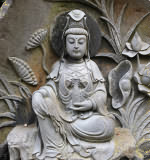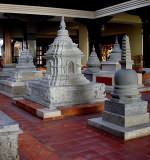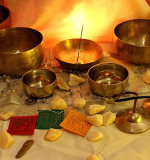| Baixe e instale a(s) fonte(s) indispensável(is) para ver o sânscrito em toda a sua glória Leia Transliterando (2) (português) para entender completamente o sistema de transliteração. |
Haṭhayogapradīpikā: Section 2 (pure)
Ṣaṭkarma e Prāṇāyāma - Tradução pura
Tradução ao português brasileiro em progresso
Introduction
Hi, Gabriel Pradīpaka once again. This is the first section of Haṭhayogapradīpikā. The subject to be dealt with is "Ṣaṭkarma and Prāṇāyāma" --"The Six Actions and Prāṇāyāma". The word "Prāṇāyāma" consists of two terms: prāṇa and āyāma. The former means "vital energy" while the latter has several meanings, viz. "restraining, stopping, expansion, dimension, etc.". Thus, Prāṇāyāma may be translated in different ways according to how you translate "āyāma": "Restriction of the vital energy", "Stoppage of the vital energy", "Expansion of the vital energy", "Dimension of the vital energy" and so on. Thus, it is preferable to leave the word "Prāṇāyāma" as such, that is, in Sanskrit, for the sake of brevity and simplicity.
Of course, in the Yoga world the word Prāṇāyāma is very often translated as "respiratory exercise", but though this is a "practical" translation, it is not a true one at all. No, Prāṇāyāma is much much much more than a mere breathing exercise, and you will realize the meanings of my words as you read the present chapter.
This is a "pure translation" document, that is, there will be no original Sanskrit, but sometimes there will be a minimal quantity of transliterated Sanskrit in the translations themselves of the stanzas. Of course, there will not be any word for word translation. Anyway, there will be very often transliterated Sanskrit in the explanatory notes. If you are a blind person using a screen reader and do not want to read the notes, or simply if you are not blind but want to skip the notes, click on the respective "Skip the notes" link to jump directly onto the next stanza.
Read carefully the warnings and tips I give you below.
Warning: All methods and techniques taught in this scripture MUST be practiced under the proper guidance of a qualified teacher. To practice them by oneself is generally DANGEROUS.
And the warning is still more emphasized here, i.e. in the present section dealing with "Ṣaṭkarma and Prāṇāyāma". To practice them without appropriate guidance will easily lead you to DISEASE or even DEATH. You must not practice those six actions nor touch your breathing processes without the help of a proficient master, or you will sorry later... sure thing.
Act wisely then. Of course, this site takes no responsibility in case you decide to ignore the present warning.
Important: All that is in brackets and italicized within the translation has been added by me in order to complete the sense of a particular phrase or sentence. In turn, all that is between double hyphen (--...--) constitutes clarifying further information also added by me.
When reading this scripture, remember the place and time in which it was written, that is,
India during the medieval age. If you forget that, you will not understand some advises, practices and the like recommended by Svātmārāma (the author).
Section 2: Ṣaṭkarma and Prāṇāyāma
And now that Āsana or Posture has become firm, the Yogī, having controlled (his body and) being on an adequate moderate diet, should practice the Prāṇāyāma-s through what is taught by the Guru||1||
When the vital air moves, the mind moves; (when) it does not move, (the mind) remains motionless. Due to that (steadiness of the vital air), the Yogī attains steadiness. Hence, (such a Yogī) should restrain the vital air||2||
As long as the vital air remains in the body, so long (that) is called life. Death is the departure (from the body) of that (vital air). Therefore, one should restrain the vital air||3||
When the subtle channels --nāḍī-s-- are full of impurities, the vital air does not pass through the middle (channel) --i.e. Suṣumnā--. How (then is) the State devoid of mind going to occur, (and) how (is) accomplishment or success going to take place?||4||
When the whole group of subtle channels1, which is full of impurities, attains purification, only then the Yogī becomes fit for gathering and retaining vital energy||5||
Skip the notes
1 Alternately, the phrase "sarvaṁ nāḍīcakram" may be translated as "all the subtle channels and Cakra-s".
Therefore, (the Yogī) should do Prāṇāyāma with a sattvic --pure, good, virtuous, etc.-- thought always, so that the impurities standing in the subtle channel Suṣumnā attain purification indeed||6||
Assuming the Lotus Posture in "baddha" --tied-- version, the Yogī should inhale the vital energy through the moon (channel) --the left nostril--. After retaining (it) according to his power or capacity, he should exhale again through the sun (channel) --the right nostril--||7||
And having drawn the vital energy through the sun (channel) --the right nostril--, he should fill (his) belly gradually. After performing Kumbhaka --i.e. stoppage and retention of breath-- duly, he should exhale again through the moon (channel) --the left nostril--||8||
Having inhaled with that (very nostril) through which he had exhaled, (such a Yogī) should retain (his breath) to the utmost of his capacity. And after that, he should exhale through the other (channel)... gradually!... (and) not impetuously||9||
If (such a Yogī) would absorb the vital energy through Iḍā --the left nostril--, he should expel (it) again through the other (nostril after keeping it) retained. Having inhaled through Piṅgalā, (and) retaining (his) breath (inside) likewise, he should let (it) go through the left (channel) --the left nostril--. For the ones who possess self-control (and) perform always the practice in this way, i.e. through the sun --the right nostril-- (and) the moon --candramās-- --the left nostril--, the groups of subtle channels become pure after three months||10||
(That very Yogī) should practice the breath retentions four times (every day): early in the morning, at noon, in the evening and at midnight; (so that those retentions are) gradually (increased) up to eighty (times in one sitting)||11||
In the inferior (stage) there is perspiration; in the middle (stage) there is trembling; (while) in the superior (stage the Yogī) achieves steadiness. For that reason, (such a Yogī) should retain the (vital) air||12||
(That Yogī) should rub (his) body with the water --sweat-- arisen from the adequate (practice of Prāṇāyāma). Through that (act), bodily firmness and freshness --lit. lightness-- appear||13||
In the beginning of the practice, (that) food (consisting of) milk (and) clarified butter is recommended. Afterward, when the practice has become firm, abiding by such observances is not (necessary any longer)||14||
Just as the lion, the elephant (and) the tiger get very gradually obedient and docile, so the vital air is controlled (little by little). Otherwise, (such a vital air) destroys the seeker||15||
By the adequate Prāṇāyāma, the destruction of all diseases is brought about. By means of the improper practice, (there is) emergence of all diseases||16||
Hiccup and asthma; together with cough, headaches, ear (and) eye pains, (and) various (other) diseases appear due to the disturbances of the vital air||17||
(Such a Yogī) should exhale very skillfully the vital air, and with (the same great) skill he should inhale (it). In turn, (in the same way), with that very proficiency, he should retain (it). Thus, he attains Perfection or Siddhi||18||
Nevertheless, when purification of the subtle channels takes place, so also (there are) external symptoms: bodily thinness (and) brightness. Then, (that Yogī) has succeeded definitely||19||
(When that very Yogī can perform) the retention of the vital air at will, (there occurs) the kindling of the digestive power. (At that time,) because of purification of the subtle channels, the manifestation of Nāda or divine inner Sound (accompanied by) a condition free from diseases arises||20||
(If there is) too much fat (or) phlegm, (such a Yogī) should practice the Six Actions --viz. Ṣaṭkarma-- firstly --i.e. before Prāṇāyāma--. But, another person should not practice those (Six Actions) if there is absence of unbalanced humors||21||
Dhauti as well as Basti; Neti, Trāṭaka and also Nauli; and (lastly) Kapālabhāti... these are considered as the Six Actions||22||
This group of Six Actions, which effects purification of the water-jar --i.e. the body--, is to be kept secret. As a whole, it has manifold attributes and qualities, (and) is worshipped by the eminent Yogī-s||23||
Therefore, Dhauti --Internal Cleansing-- (is now explained):
Through what is taught by the Guru, (that Yogī) should swallow gradually a wet cloth, which is four thumbs --about three inches or 7.5 cm.-- wide (and) fifteen hands --about 1.5 m.-- in length; and he should take it out again. That (first) Action is said to be Dhauti||24||
There is no doubt that cough, asthma, diseases of the spleen, leprosy and the twenty (kinds of) diseases of the phlegm, disappear through the Action (called) Dhauti||25||
And now, Basti --Yogic Enema-- :
Sitting in Utkaṭāsana, (immersed) in water reaching up to (his) navel (and) with a tube inserted into the anus; (that Yogī) should contract the Ādhāra --anal sphincter--. That cleansing with water (is) the Action (called) Basti||26||
Enlargement of glands, spleen (and) abdomen, and even (the ailments) arising from (the lack of equilibrium of) wind, bile (and) phlegm... all (these) diseases are destroyed by means of the Action (known as) Basti||27||
By practicing the Action called Jalabasti --i.e. Basti with water--, (it) bestows purification on the bodily constituents, the Powers of perception and action, (and) the inner (psychic) organ; (and) also (gives) beauty (as well as) the kindling of the digestive fire. (Finally, Jalabasti) destroys all excess of unbalanced humor||28||
And now, Neti --Nasal Cleansing--:
(Such a Yogī) should insert a very soft thread, about 9 inches or 23 cm. --either as a long span between the extended thumb and little finger, or as the distance between the wrist and the tip of the fingers-- in length, through the nasal duct. And (after having inserted it so,) he should cause it to come out of the mouth. This (Action) is called Neti --Nasal Cleansing-- by the Perfected Beings||29||
Neti cleanses the cranium and certainly grants Divine Vision --i.e. Clairvoyance--. It also destroys quickly the multitude of diseases arising above the collar bone||30||
And now, Trāṭaka --Fixing the eyes on one object--:
(That) attentive and engrossed (Yogī) should look with a fixed gaze at a minute mark until tears appear. (This Action) is named Trāṭaka --Fixing the eyes on one object-- by the Masters||31||
Trāṭaka sets (one) free from eye diseases, fatigue and sloth, etc., (and closes) the door (through which those ailments enter). It should be kept secret carefully as if it were a little golden box||32||
And now, Nauli --Undulating Belly--:
Leaned forward (and) after having protruded the abdomen, (such a Yogī) should cause it to turn round from right to left by a fast rotating impulse --vega--. This (Action) is called Nauli by the Perfected Beings||33||
This Nauli always produces bliss as well as bestows good digestion, etc., by kindling (the digestive fire and thus healing) slow digestion. (It) also destroys all disorders of the (three) humors and (is) the primordial active practice of Haṭhayoga||34||
And now Kapālabhāti --the one that makes the cranium shine--:
Exhalation (and) inhalation --pūra-- (are to be performed) very quickly, like the bellows of a blacksmith. (This) is generally known as Kapālabhāti, which completely destroys (all) disorders of phlegm||35||
Excessive phlegm, impurities, etc., are (all) gone by the Six Actions. Afterward, (that Yogī) should perform Prāṇāyāma (and he) easily has success||36||
However, according to some teachers: "Only by the Prāṇāyāma-s all impurities decay". (Any) other Action --i.e. any of the aforesaid Six Actions-- is not held in high esteem||37||
And now Gajakaraṇī --lit. the one which does like an elephant--:
(That practice which consists of) vomiting the thing(s) contained in the stomach by raising the vital air (whose name is) Apāna up to the throat is called "Gajakaraṇī" by the knowers of Haṭhayoga. (Thus,) through the progressive becoming accustomed (to this practice), the cakra-s (and) subtle channels come under (one's) control||38||
Even the thirty gods, beginning with Brahmā, became (beings) totally devoted to the practice of Prāṇāyāma for fear of death. For that reason, (such a Yogī) should practice Prāṇāyāma||39||
As long as the vital air (is) confined in the body, the mind (is) calm (and) the gaze (is concentrated) on the space between the eyebrows, so long what is the reason for fear of death --lit. "time", because time is usually identified with death--?||40||
Through the duly performed restraints of the vital energy, the subtle channels (and) cakra-s are completely purified. By bursting open the Suṣumnā's doorway, the vital air easily enters (it)||41||
And now Manonmanī --mind with no thought--:
When the vital air moves in the middle (passage) --i.e. Suṣumnā--, mental steadiness is generated. Such a condition of perfect firmness of mind (is) that very state of Manonmanī||42||
For attaining that --i.e. Manonmanī--, the knowers of the rules and precepts perform various Kumbhaka-s --i.e. stoppages and retentions of breath--. (So,) by the practice of Kumbhaka-s in various ways, (that Yogī) obtains the wonderful Perfection||43||
And now the various Kumbhaka-s --i.e. stoppages and retentions of breath--:
The eight Kumbhaka-s (are:) Sūryabhedana --also called Sūryabheda--, Ujjāyī, Sītkārī, Śītalī, as well as Bhastrikā, Bhrāmarī, Mūrcchā (and) Plāvinī||44||
Certainly, at the end of inhalation, the Bandha or Lock --in a few words: a kind of posture in which the energy is locked into a specific zone of the body-- known as Jālandhara is to be performed. (In turn,) at the end of Kumbhaka --i.e. stoppage and retention of breath-- (and) beginning of exhalation, (the Lock whose name is) Uḍḍīyāna is to be done indeed||45||
By a quick contraction of the perineum --this is Mūlabandha or the Lock called Mūla--, while at the same time a contraction of the throat is done --this is Jālandharabandha or the Lock called Jālandhara--, the vital energy is made flow into the Brahmanāḍī with (the additional help of) a stretching the rear part of the body in its middle zone --i.e. the abdomen-- --by "paścimatānena" the author is referring to Uḍḍīyānabandha and not to the well-known Āsana (Posture) called Paścimatāna or Paścimottāna. In other words, this is Mahābandha (the Great Lock) or the conjunction of the three Locks: Mūla, Jālandhara and Uḍḍīyāna--||46||
Having raised the apāna, (that very Yogī) should lead the prāṇa downward from the throat. (By doing so,) the Yogī becomes completely free from old age (and) appears with the youthful vigor of the sixteen years old||47||
And now Sūryabheda --or Sūryabhedana; lit. "the one who pierces the Sun" (the Sun is Piṅgalā)--:
Sitting comfortably and firmly assuming the posture, then the Yogī, after attracting gradually the external vital air through the right subtle channel --i.e. Piṅgalā, which ends in the right nostril--, should retain his breath until it encompasses the hair and the tips of the nails. After that, very gradually, he should exhale the vital air through the left subtle channel --i.e. Iḍā, which ends in the left nostril--||48-49||
This excellent Sūryabheda which purifies the cranium, destroys the imbalances of the wind --one of the three bodily humors, the other two are phlegm and bile-- (and) eliminates the affection (brought about) by the worms, is to be done over and over again||50||
And now, Ujjāyī --lit. the victorious one--:
After closing the mouth (and) attracting --i.e. inhaling-- gradually the vital air through both subtle channels --i.e. Iḍā and Piṅgalā, which end in the nostrils--, so that (the breath) is truly felt from the throat down to the heart (and) produces a loud sound, (such a Yogī) should hold (his) breath as before (and) accordingly exhale the vital energy through Iḍā --the subtle channel ending in the left nostril--. (This Kumbhaka --i.e. stoppage and retention of breath-- called Ujjāyī) destroys the imbalances of the phlegm in the throat (and) increases the digestive fire||51-52||
(Also,) the Kumbhaka known as Ujjāyī eliminates the disorders related to the bodily constituents, dropsy (and) the subtle channels. (This Ujjāyīprāṇāyāma) can be certainly performed while moving (or) remaining still||53||
And now Sītkārī --lit. the hissing one--:
Sītkārī, viz. (that Prāṇāyāma) in which the air is inhaled through the mouth --without separating the teeth-- (and is exhaled) through the nose, should be done in the indicated way. Thus, by means of the practice, (such a Yogī becomes) a second Kāmadeva --the god of love--||54||
(Such a Yogī who practices Sītkārī) is the doer of Creation (and) Dissolution, (and) he is greatly honored by the group of Yoginī-s. (In him) there is neither hunger nor thirst (nor) sleep, nor does sloth appear||55||
Besides, (the guṇa called) Sattva --lit. "goodness, purity"; a quality of Prakṛti, the origin of the material world-- in the body becomes free from all disturbances. (That Yogī,) by this method, (becomes) the Lord of the Yogī-s on (this) earth indeed||56||
And now, Śītalī --lit. "the cool one", i.e. this Prāṇāyāma refreshes one's body--:
Having absorbed air through the tongue (and after) the practice of Kumbhaka --i.e. stoppage and retention of breath-- as (described) before, the wise one, gently --i.e. little by little--, should exhale the air through both nostrils||57||
No doubt this Kumbhaka called Śītalī attacks diseases (such as) enlargement of the stomach, spleen, etc., (as well as) fever, bile (imbalance), hunger, thirst (and) poisons||58||
And now, Bhastrikā --bellows--:
In placing the two beautiful soles of the feet on top of the thighs, the lotus posture occurs. This (posture) destroys all sins||59||
Having assumed the lotus posture properly, with (his) neck (and) abdomen in alignment, the wise one, by closing the mouth, should exhale the vital energy through the nose strenuously||60||
And he should inhale the vital air quickly down to the heart lotus. Accordingly, the (resulting) loud sound (firstly located in) heart (and) throat --kaṇṭha-- is felt up to the cranium||61||
Again, he should exhale and inhale likewise repeatedly, in the same way as a bellows is pumped rapidly by the blacksmith ||62||
Thus, the vital air situated in one's own body should be pumped with attention and wisdom. When the bodily fatigue appears, then (that wise one) should inhale through the sun (channel) --i.e. Piṅgalā, the subtle channel ending in the right nostril--||63||
So, the abdomen is going to become filled with air; then quickly, (when it is full,) he should hold --i.e. he should close-- the nose firmly without (using) the middle and index fingers, (viz. by using the thumb and ring finger)||64||
Having done systematically Kumbhaka --i.e. stoppage and retention of breath--, (that very wise one) should exhale the air through Iḍā --the subtle channel ending in the left nostril--. (This Kumbhaka) annihilates (the imbalances of) air, bile (and) phlegm (as well as) increases the digestive fire||65||
(This) Prāṇāyāma, which is pleasant (and) beneficent, quickly arouses Kuṇḍalinī (and) removes the obstructions (due to excess of) phlegm, etc. lying at the entrance of Brahmanāḍī --the innermost portion of Suṣumnā--||66||
Truly, this Kumbhaka called Bhastrā (or Bhastrikā) must be performed particularly (by that wise Yogī, since) it pierces totally the three knots that exist in the body||67||
And now, Bhrāmarī --lit. "relating to a bee"--:
Inhalation (is to be performed) quickly, (which results in) a reverberating sound (like) the sound (emitted) by a male black bee; (while) exhalation (is to be done) slowly, (which produces) a sound (like the one emitted by) a female black bee. Thus, by means of the practice emerges in the mind a little Play (full) of Bliss (typical) of the Lords among the Yogī-s||68||
And now, Mūrcchā --lit. "fainting"--:
At the end of inhalation, after having assumed Jālandharabandha most firmly, (the Yogī) should exhale gradually. This (Prāṇāyāma) is known as Mūrcchanā --or Mūrcchā-- (because it brings about) mental fainting (and consequently) grants happiness or pleasure||69||
And now, Plāvinī --the one which makes float--:
(This Yogī,) with the internal region of (his) abdomen full of noble vital air introduced (by himself), easily floats like a lotus leaf, even in deep waters||70||
Prāṇāyāma (is) said (to be) of three kinds: "Exhalation, inhalation (and) retention --kumbhaka--". (In turn,) retention (is) considered as of two types: "connected and unconnected --or isolated--"||71||
Until there is perfection as regards Kevalakumbhaka --unconnected retention--, up to then (the wise Yogī) should practice Sahitakumbhaka --connected retention--. Once he has abandoned exhalation (and) inhalation, that retention of air (will) easily (ensue to him)||72||
This aforesaid Prāṇāyāma (is) certainly that unconnected retention. When the unconnected retention is perfected there is absence of exhalation (and) inhalation||73||
There is nothing difficult to be obtained in the three worlds for him who can perform the unconnected retention by retaining the air at will||74||
Besides, (through the unconnected Kumbhaka --i.e. stoppage and retention of breath--, such a Yogī) acquires the state of Rājayoga, (and) there is no doubt about it. By the retention of breath, the awakening of Kuṇḍalinī (takes place), and by means of (that) awakening of Kuṇḍalinī, Suṣumnā becomes free from obstructions, arising then the perfection of Haṭhayoga||75||
Without Haṭhayoga, Rājayoga is not successful; (and) without Rājayoga, Haṭhayoga (is not either). For that reason, (the Yogī) should practice both till attaining accomplishment or perfection||76||
In the final stage of the Prāṇa --vital energy-- stoppage by Kumbhaka, (that wise Yogī) should make (his) mind supportless --i.e. his mind should not have any support at all--. Thus, through (this) practice, he achieves the state of Rājayoga||77||
A beautiful (bodily) appearance, thinness, tranquility and purity in (one's) countenance, manifestation of the inner sound, perfectly clear eyes, diseaselessness, victory over semen or ova, a kindling of the digestive fire (and) purification of the subtle channels... (all of them are) the mark of perfection in Haṭhayoga||78||
(Thus,) the second teaching in Haṭhayogapradīpikā is finished|
Concluding remarks
As a final conclusion, I have to warn you again about the danger of practicing "Ṣaṭkarma and Prāṇāyāma", specially the latter, without the help of a proficient guru. No doubt that the Six Actions are dangerous if practiced improperly, but Prāṇāyāma is even more dangerous when performed with no expert assistance. The main reason is very simple indeed. There are two kinds of respiratory processes: 1) Involuntary, 2) Voluntary.
Your "normal" breathing is involuntary, but when you practice Prāṇāyāma-s you have to use the voluntary process. This is risky because while you are using the voluntary breathing, the involuntary one is stopped. If you insist on practicing Prāṇāyāma over and over again, without due guidance by a master, what will probably happen is that the involuntary process of breathing will be spoiled somehow... and when this occurs, it is very difficult to restore it to its previous condition. Besides, in the involuntary process (normal), your body regulates the breathing according to the diet. If you change your breathing process, you will have to change your diet too... and only a proficient guru can tell you what you should eat in this case.
So, my final recommendation is that people without the help of a guru expert in "Ṣaṭkarma and Prāṇāyāma" MUST NOT practice them at all. Thus, till you get such a guru, read this chapter but do not do any of the practices described by the author. I think I have been clear enough... anyway, read the stanzas 15 through 17 if you are still doubtful. See you on the next chapter which will deal with Mudrā and Bandha (Seal and Lock).
Further Information
Este documento foi concebido por Gabriel Pradīpaka, um dos dois fundadores deste site, e guru espiritual versado em idioma Sânscrito e filosofia Trika.
Para maior informação sobre Sânscrito, Yoga e Filosofia Indiana; ou se você quiser fazer um comentário, perguntar algo ou corrigir algum erro, sinta-se à vontade para enviar um e-mail: Este é nosso endereço de e-mail.






























